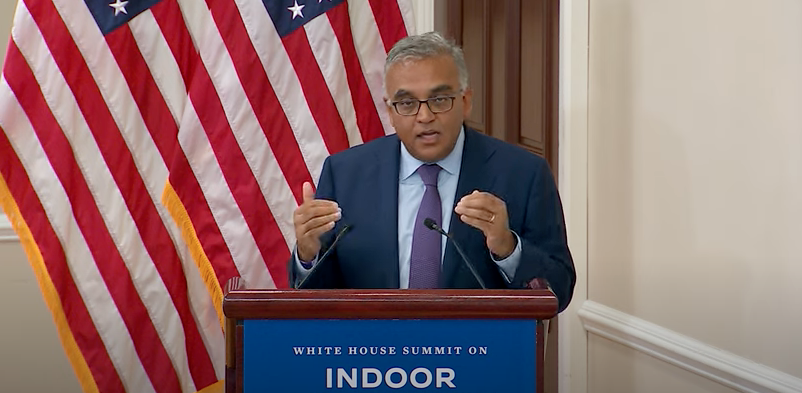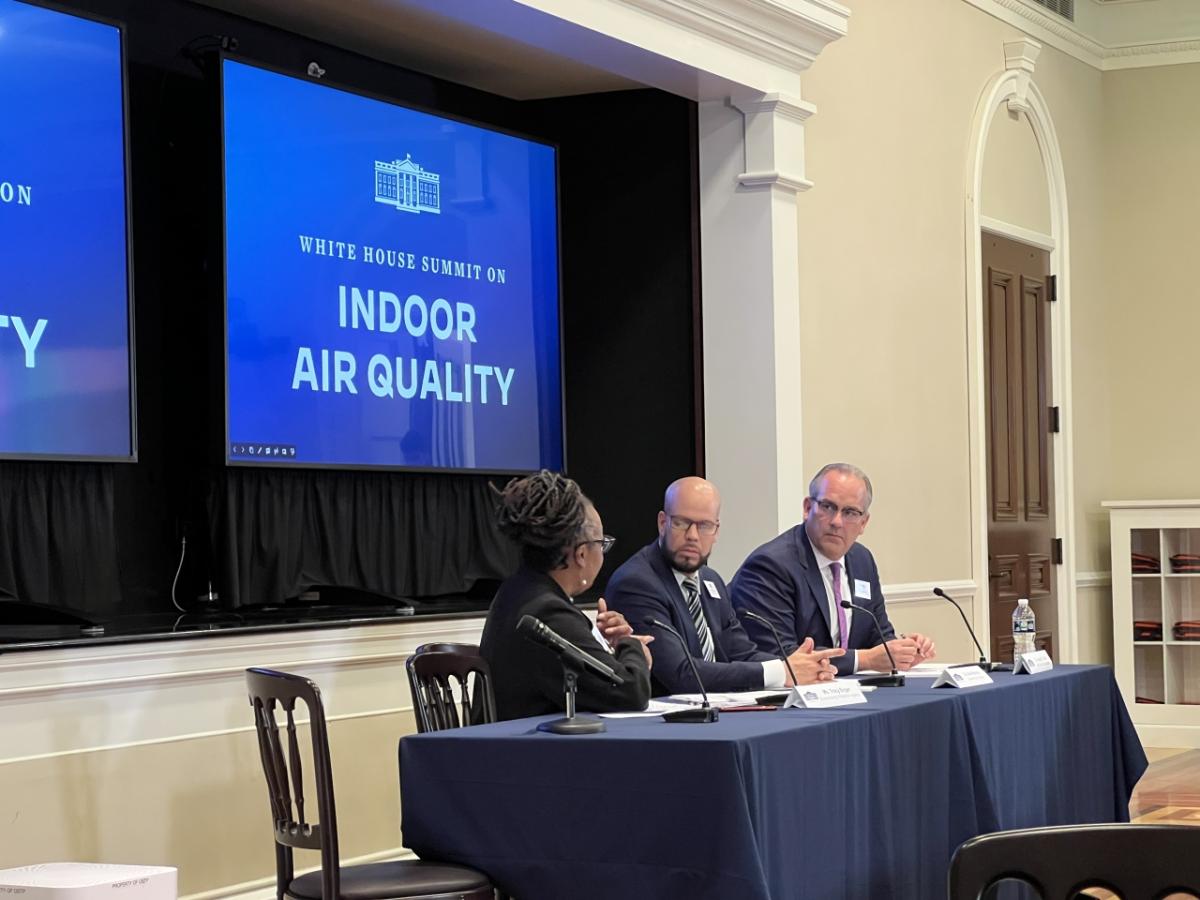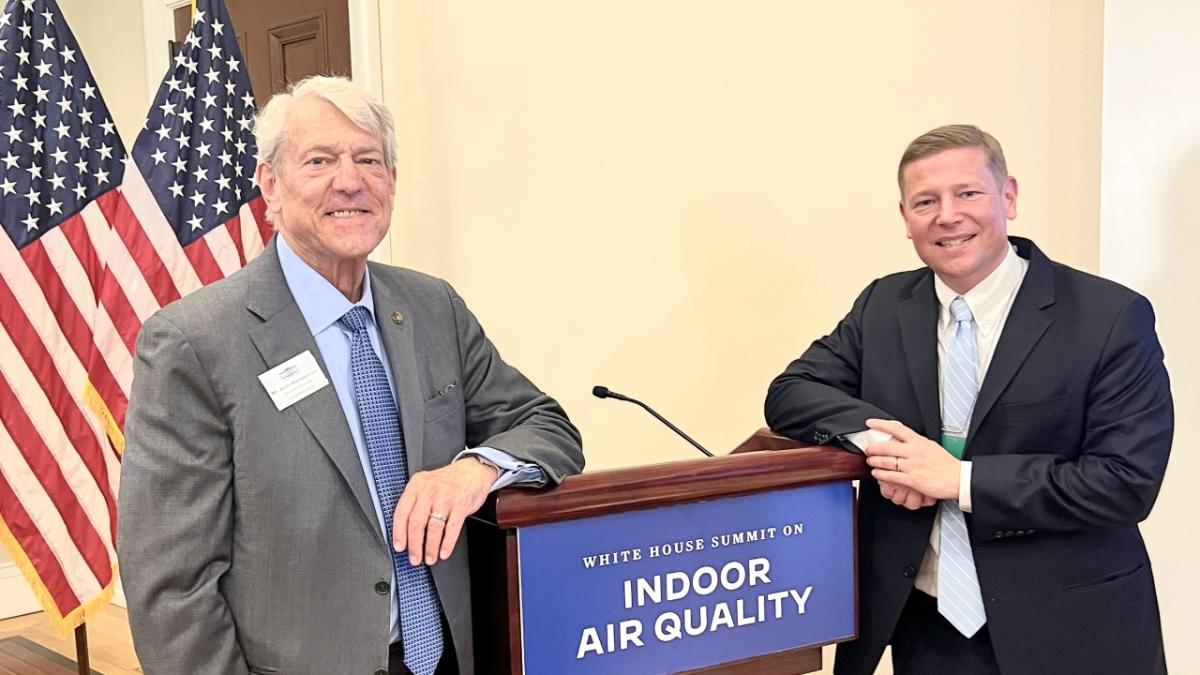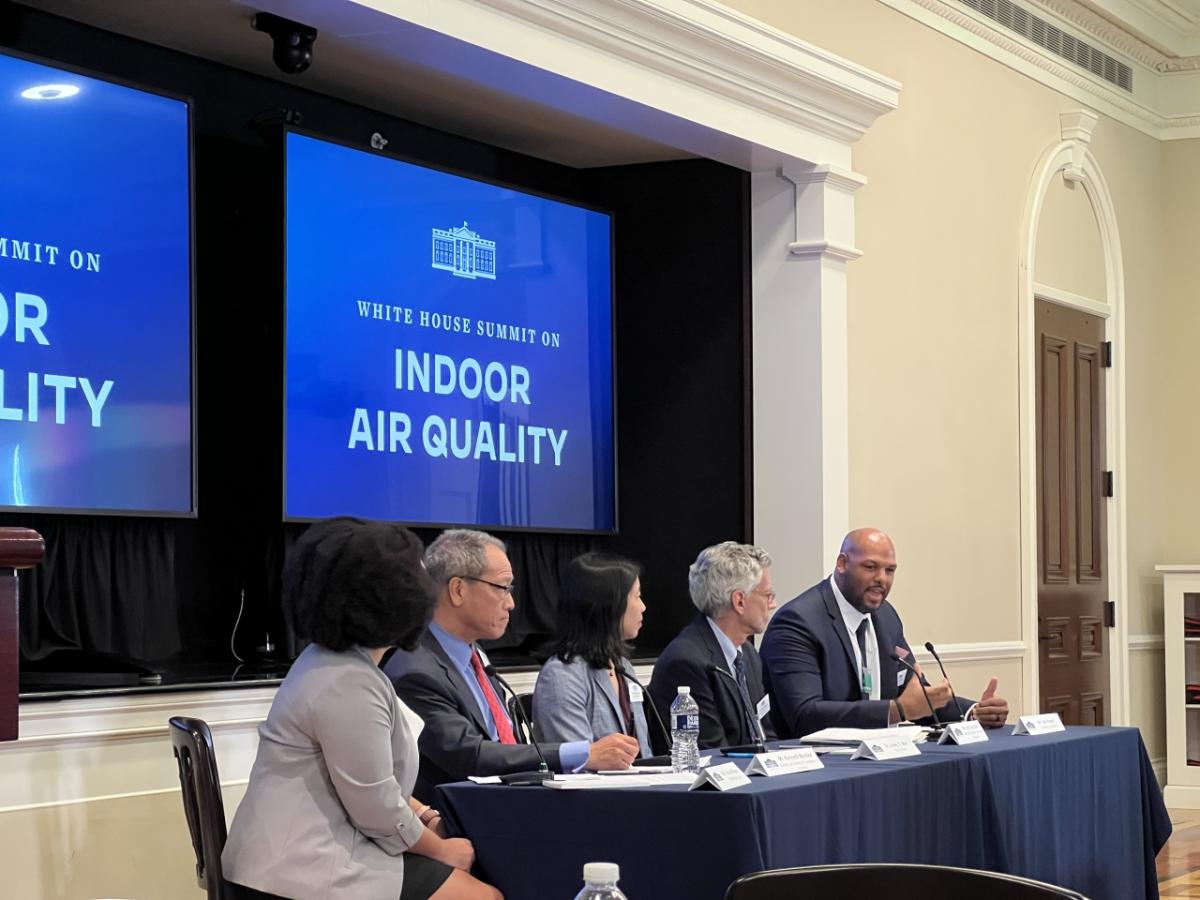Biden Administration Shines a Light on Healthy Buildings
For the first time, the White House hosts a summit on indoor air quality, calling for collective action to chart a path to bring the benefits of clean indoor air to everyone
On Tuesday, the Biden Administration convened a signature group of leaders, experts and advocates at the White House for its first-ever Summit on Indoor Air Quality (IAQ). During the event, speakers grappled with key questions about ramping up efforts to improve indoor air quality, not just as way to prevent the spread of infectious diseases, like COVID-19, but also to expand the many associated health benefits to everyone.
Since the launch of the Administration’s National COVID-19 Preparedness Plan, which was released in March, the White House has elevated the role of healthy buildings, and indoor air quality in particular, as a powerful strategy to combat COVID-19 and fortify and enhance human health. As part of the preparedness plan, the Administration also launched the Clean Air in Buildings Challenge, an effort to amplify the importance of improving ventilation and spur companies, schools and organizations to take action. At the time, we commended President Joe Biden for taking these important steps in our article titled, “A New Era for Indoor Air Quality.”
IAQ is a central pillar of healthy buildings, which is reflected in the WELL Building Standard and how it advances a robust and holistic approach to advancing clean indoor air. It’s why all of us at the International WELL Building Institute (IWBI), and across our global community, were so excited for this first-ever White House Summit shining a light on IAQ.
“We need healthy buildings because we need healthy communities.”
Dr. Ashish Jha, who was tapped by President Biden to lead the White House COVID-19 Response, kicked off the event with a statistic that many in the healthy buildings community know well — that we spend approximately 90% of our lives inside a building.
In the context of his work as the President’s lead on the federal government’s COVID-19 response, Dr. Jha said the pandemic has increased the critical importance of air quality in the fight against infectious disease. But he also noted a larger context for prioritizing IAQ, saying, “We need healthy buildings because we need healthy communities.” Making a comparison to water quality, he underscored that clean indoor air quality is rooted in public health.
He also discussed the challenge moving forward: how do we chart a path to bring the benefits of IAQ to more people, fortifying us in the face of the “burden of respiratory illnesses” now and into future.
“That’s why this Administration has made improving IAQ a priority,” said Dr. Jha, while adding that indoor air quality (IAQ) is the “next frontier” for public health. “We cannot emerge from this pandemic not having done this.”
Clean indoor air is “a force multiplier for reducing the spread of infectious disease,” but it also addresses a chronic issue. While not mentioned at the summit, according to the Environmental Protection Agency (EPA), the levels of indoor air pollutants are often 2 to 5 times higher than outdoor levels, and in some cases these levels can exceed 100 times that of outdoor levels. So, the air we breathe in our buildings still needs much more attention.
“Our buildings have an outsized impact on our health.”
While the event was billed with a focus on indoor air quality, it also quickly became a larger call to action to accelerate healthy buildings. The reason is simple.
“Our buildings have an outsized impact on our health,” said Joseph Allen, head of the Healthy Buildings Program and associate professor of exposure assessment science at Harvard University’s School of Public Health.
Allen signaled to the audience that we are now an indoor species. At 47-years-old, Allen said he’s spent more than 42 years of his life inside a building, what he referred to as his “indoor age,” calculated by multiplying age by 0.9.
Because we spend so much time indoors, Allen said that what’s happening inside our buildings has a huge impact on our health, adding that a building facility manager has more of an impact on someone’s health than their doctor.
In the face of COVID-19 and other immediate threats, Allen said ramping up and deploying healthy building strategies must be a major part of the solution. “Buildings should be the first line of defense,” he said. But he also urged that we do much more to focus on buildings as a key public health strategy, saying it’s a singular opportunity to protect and improve public health and well-being.
“Academic performance is tied to building performance which is tied to health performance.”
Another session focused on K-12 schools, one of the most important sectors where IAQ improvements are needed — improvements that influence both student health and student learning.
The panel featured two school superintendents – Jesus Jara of Clark County School District in Nevada and Alex Marrero of Denver Public Schools. Both acknowledged the connection between student health and student learning. “A lot of research has shown that academic performance is tied to building performance which is tied to health performance,” said Marrero. Echoing the point, Jara said, “We know healthy buildings will produce healthy kids.”
Tracy Enger, a facilitator in EPA’s Indoor Environments Division, moderated the schools session and highlighted EPA’s IAQ Tools for Schools resource, which provides “a robust suite of tools to help schools identify, correct, and prevent a wide range of environmental health and safety risks, and to put in place a sustainable system to institutionalize a successful program at the school or school district level.”
School leaders across the country have taken up the mantle of leading on IAQ and pursuing ambitious action plans to elevate health across the sector. Jara noted that he hired an IAQ fellow to ensure they had a resident expert on call. Both superintendents talked about increasing its districts filtration standards and taking other proactive steps to address indoor air.
“This is non-negotiable,” said Marrero, referring to what must now be a permanent focus on IAQ as a fundamental strategy for advancing healthy schools. He also said that to better institutionalize healthy schools, school districts will need to codify it through policy and prioritize it consistently in annual budget allocation. “What happens when ARP [American Rescue Plan] goes away?”
Both superintendents made note of how hard it is for local school districts to address what often are chronic funding gaps for school facility infrastructure, even despite historic federal funding from the American Rescue Plan. Nationally, underinvestment in school facilities is a massive issue. According to the 2021 State of our Schools report, which was led by IWBI, 21st Century School Fund and the National Council on School Facilities, the U.S. is underinvesting in school buildings and grounds by $85 billion very year.
“The co-benefits of improved indoor air are enormous.”
Speakers from across government, business and academia also highlighted the health and economic benefits of improving IAQ.
“The co-benefits of improved indoor air are enormous,” said David Michaels, an epidemiologist and professor at George Washington University School of Public Health, who moderated a panel titled, “Why Improving Indoor Air Quality Makes Good Business Sense.”
Several featured speakers from the private sector noted how these health strategies align with goals to improve productivity, reduce absenteeism, increase retention and boost recruitment efforts.
“Indoor air quality is a core value of what we look at in our real estate,” said Michele Schneider, senior vice president of global workplace services at Salesforce, acknowledging its health and productivity benefits.
Leading researchers, like Allen and Dr. Linsey Marr, professor of civil and environmental engineering at Virginia Tech, echoed similar reasons why organizations should be looking closer at healthy building solutions.
“Investing in healthy buildings is just good business,” said Allen, adding that it helps mitigate risk while protecting an organization’s people and its assets.
Remarking on his lifelong career of taking care of buildings, Kevin Kampschroer, who leads the Office of Federal High-Performance Green Buildings at the U.S. General Services Administration, reminded everyone why tending to buildings is ultimately about tending to people.
“The only reason buildings exist is to take care of the people within them,” said Kampschroer. He also talked about several large shifts over the past decades in how we think about managing buildings – from simple asset management to what is now seen as a powerful vehicle to advance health, sustainability and equity.
Other speakers emphasized the ongoing need to build awareness and understanding around IAQ. “I think demystifying indoor air quality is a great way of helping people understand it,” said Shelley Miller, professor of mechanical engineering at the University of Colorado Boulder.
Delivering IAQ Benefits to Everyone
Assistant Secretary Taryn Williams, who leads the Department of Labor’s Office of Disability Employment Policy, moderated another session titled, “Clean Air Benefits Everyone,” which explored strategies and policies to help ensure IAQ improvements protect everyone, including our most vulnerable populations. “How do we prioritize equity?” she asked, in opening remarks for the session.
Speakers in the session noted that the health benefits associated with clean indoor air are many, yet should not be limited to the few.
“Wealth and privilege shouldn’t determine if you have access [to improved IAQ],” said Carl Howell, chief program officer at Community Teamwork. “We need to invest in this country so everyone has access to healthy air quality spaces.”
John Auerbach, a speaker representing the Centers for Disease Control and Prevention (CDC) who serves as its director of intergovernmental and strategic affairs, talked about the need for more community involvement. “You need to listen to the communities most affected and bring them to the table,” he said.
Doing More Together
Several of the White House speakers, including Jha, noted that the federal government will continue to do its part, marshalling its expertise and relevant programs across agencies to promote and advance IAQ improvements. Some of the key efforts mentioned included:
- A new website dedicated to IAQ (www.whitehouse.gov/cleanindoorair), which is also where public and private sector stakeholders can commit to the Clean Air in Buildings Challenge.
- The Department of Energy’s Efficient and Healthy Schools Campaign, which is engaging with school districts across the country and also offering one-on-one consultations to school districts looking for guidance on IAQ improvements.
- EPA is taking steps to develop resources and technical assistance offerings to better support indoor air quality management practices, recently announcing a Request For Information to help inform how it shapes those future resources.
Perhaps universally, speakers at the event expressed a deep gratitude to the White House for its work to raise awareness about IAQ. The feeling was mutual among the White House organizers. Dr. Arati Prabhakar, director of the White House Office of Science and Technology Policy, in just her first week on the job, provided closing remarks, expressing her thanks to all the participants and her admiration for the collective work being done to advance cleaner indoor air.
View original content here.





